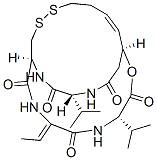
(1S,4Z,7S,10S,11E,20R)-4-ethylidene-7,20-dipropan-2-yl-9-oxa-15,16-dit hia-3,6,18,21-tetrazabicyclo[8.7.6]tricos-11-ene-2,5,8,19,22-pentone
- русский язык имя
- английское имя(1S,4Z,7S,10S,11E,20R)-4-ethylidene-7,20-dipropan-2-yl-9-oxa-15,16-dit hia-3,6,18,21-tetrazabicyclo[8.7.6]tricos-11-ene-2,5,8,19,22-pentone
- CAS №128517-07-7
- CBNumberCB31260794
- ФормулаC24H36N4O6S2
- мольный вес540.7
- номер MDLMFCD18433404
- файл Mol128517-07-7.mol
| Температура плавления | 219-224°C |
| Температура кипения | 942.8±65.0 °C(Predicted) |
| плотность | 1.174 |
| температура хранения | -20°C |
| растворимость | Soluble in DMSO (up to 10 mg/ml). |
| форма | powder |
| пка | 11.33±0.60(Predicted) |
| цвет | white to beige |
| Стабильность | Stable for 2 years from date of purchase as supplied. Solutions in DMSO may be stored at -20° for up to 1 month. |
| Словарь онкологических терминов NCI | depsipeptide; FR901228; Istodax; romidepsin |
| FDA UNII | CX3T89XQBK |
| Словарь наркотиков NCI | Istodax |
| Код УВД | L01XH02 |
| UNSPSC Code | 12352200 |
| NACRES | NA.77 |
| RTECS | YV9399000 | |||||||||
| кода HS | 29349990 | |||||||||
| Токсичность | mouse,LD50,intraperitoneal,6400ug/kg (6.4mg/kg),Journal of Antibiotics. Vol. 47, Pg. 301, 1994. | |||||||||
| NFPA 704: |
|
рисовальное письмо(GHS)
-
рисовальное письмо(GHS)



-
сигнальный язык
опасность
-
вредная бумага
H301:Токсично при проглатывании.
H317:При контакте с кожей может вызывать аллергическую реакцию.
H341:Предполагается, что данное вещество вызывает генетические дефекты.
H410:Чрезвычайно токсично для водных организмов с долгосрочными последствиями.
-
оператор предупредительных мер
P201:Беречь от тепла, горячих поверхностей, искр, открытого огня и других источников воспламенения. Не курить.
P202:Перед использованием ознакомиться с инструкциями по технике безопасности.
P261:Избегать вдыхания пыли/ дыма/ газа/ тумана/ паров/ аэрозолей.
P264:После работы тщательно вымыть кожу.
P270:При использовании продукции не курить, не пить, не принимать пищу.
P272:Не уносить загрязненную спецодежду с места работы.
P273:Избегать попадания в окружающую среду.
P280:Использовать перчатки/ средства защиты глаз/ лица.
P281:Пользоваться надлежащим индивидуальным защитным снаряжением.
P301+P310:ПРИ ПРОГЛАТЫВАНИИ: Немедленно обратиться за медицинской помощью. Прополоскать рот.
P302+P352:ПРИ ПОПАДАНИИ НА КОЖУ: Промыть большим количеством воды.
P308+P313:ПРИ подозрении на возможность воздействия обратиться за медицинской помощью.
P333+P313:При возникновении раздражения или покраснения кожи обратиться за медицинской помощью.
P363:Перед повторным использованием выстирать загрязненную одежду.
P391:Ликвидировать просыпания/проливы/утечки.
P405:Хранить в недоступном для посторонних месте.
P501:Удалить содержимое/ контейнер на утвержденных станциях утилизации отходов.
(1S,4Z,7S,10S,11E,20R)-4-ethylidene-7,20-dipropan-2-yl-9-oxa-15,16-dit hia-3,6,18,21-tetrazabicyclo[8.7.6]tricos-11-ene-2,5,8,19,22-pentone химические свойства, назначение, производство
Описание
The U.S. FDA approved romidepsin (also referredto as FK228) in 2009 for the treatment of cutaneous T-cell lymphoma (CTCL) for patients who received at least one systemic therapy. Romidepsin is a natural product that was first isolated from the fermentation broth of C. violaceum. Romidepsin is the second histone deacetylase (HDAC) inhibitor approved for CTCL, the other being vorinostat,whichwas approved by the FDA in 2006. Unlike vorinostat which is a pan-HDAC inhibitor, romidepsin shows modest selectivity for class I HDACs in in vitro assays. It has been shown that after romidepsin enters the cytoplasm, the disulfide bond is cleaved by glutathione to release the sulfhydryl groupwhich chelateswith the activesite zinc of class IHDACs and inhibits the enzymatic activity at nanomolar concentrations. Although romidepsin inhibits class I HDACs, it is 17–23 times less potent as the parent than the corresponding reduced form at each isozyme. For example, the IC50 of romidepsin at HDAC1 is 36±16nM while that of the reduced form is IC50=1.6± 0.9nM.Romidepsinhasalsobeenshownto induce cell cycle arrest, differentiation, and apoptosis in tumor cells by mechanisms that cannot be completely explained by HDAC inhibition alone.Химические свойства
Pale Yellow SolidИспользование
Labelled Romidepsin (R425060). Romidepsin is a histone deacetylase inhibitor that can alter chromatin structure and gene transcription leading to multiple changes in cellular protein production. This may result in cell cycle arrest and tumor growth inhibition. Romidepsin has shown anti-proliferative activity in vitro against multiple mouse and human tumor cell lines and in vivo in human tumor xeno graft models. Romidepsin can be administered with a second agent, such as a cytotoxic agent, a steroidal agent, a proteasome inhibitor, or a kinase inhibitor.Определение
ChEBI: A cyclodepsipeptide consisting of the cyclic disulfide of (2Z)-2-aminobut-2-enoyl, L-valyl, (3S,4E)-3-hydroxy-7-sulfanylhept-4-enoyl, D-valyl and D-cystei yl residues coupled in sequence and cyclised head-to tail.Клиническое использование
Romidepsin, a histone deacetylase inhibitor, originally developed by Fujisawa (now Astellas Pharma), causes cell cycle arrest, differentiation, and apoptosis in various cancer cells. In 2004, the FDA granted fast-track designation for romidepsin as monotherapy for the treatment of cutaneous Tcell lymphoma (CTCL) in patients who have relapsed following, or become refractory to, other systemic therapies. The FDA designated romidepsin as an orphan drug and it was approved in 2009 for this indication and it was commercialized in 2010. In 2007, another fast-track designation was granted for the product as monotherapy of previously treated peripheral T-cell lymphoma. Romidepsin (FR901228) was originally discovered and isolated from the fermentation broth of Chromobacterium violaceum No. 968. It was identified through efforts in the search for novel agents which selectively reverse the morphological phenotype of Ras oncogene-transformed cells since the Ras signaling pathway plays a critical role in cancer development. Therefore, the drug could also have multiple molecular targets for its anticancer activity besides HDAC. FR901228 is a bicyclic depsipeptide which is structurally unrelated to any known class of cyclic peptides with an unusual disulfide bond connecting a thiol and Dcysteine.(1S,4Z,7S,10S,11E,20R)-4-ethylidene-7,20-dipropan-2-yl-9-oxa-15,16-dit hia-3,6,18,21-tetrazabicyclo[8.7.6]tricos-11-ene-2,5,8,19,22-pentone поставщик
| поставщик | телефон | страна | номенклатура продукции | благоприятные условия |
|---|---|---|---|---|
| +undefined-21-51877795 | China | 32965 | 60 | |
| +86-0371-86658258 +8613203830695 |
China | 29871 | 58 | |
| 0086-13720134139 | CHINA | 965 | 58 | |
| 18631714998 | CHINA | 904 | 58 | |
| 86-13657291602 | CHINA | 22963 | 58 | |
| +1-631-485-4226 | United States | 19553 | 58 | |
| +86-023-6139-8061 +86-86-13650506873 |
China | 39894 | 58 | |
| 13480692018 | CHINA | 954 | 58 | |
| 13656108824 | CHINA | 184 | 58 | |
| 18503026267 | CHINA | 9636 | 58 |